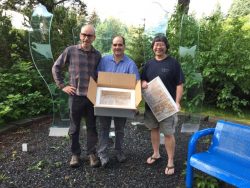Can mushrooms replace Styrofoam and keep the oceans cleaner?
July 30, 2019
Paula Dobbyn
9072749698

A University of Alaska Anchorage researcher who hopes to curb ocean pollution thinks fungi might have a useful role to play.

Philippe Amstislavski, an associate professor of public health at UAA, is experimenting with using mushrooms to create biodegradable insulation, shipping material and other environmentally friendly products.
Alaska Sea Grant, a partnership between the National Oceanic and Atmospheric Administration and UAF, is helping to measure the material’s thermal properties at the Kodiak Seafood and Marine Science Center, a research facility operated by the UAF College of Fisheries and Ocean Sciences.
Chris Sannito, ASG’s seafood technology specialist, is also coordinating commercial shipping trials for the material. Some fishermen are excited to give the mushroom-based product a try. Read more in this recent Anchorage Daily News article.


